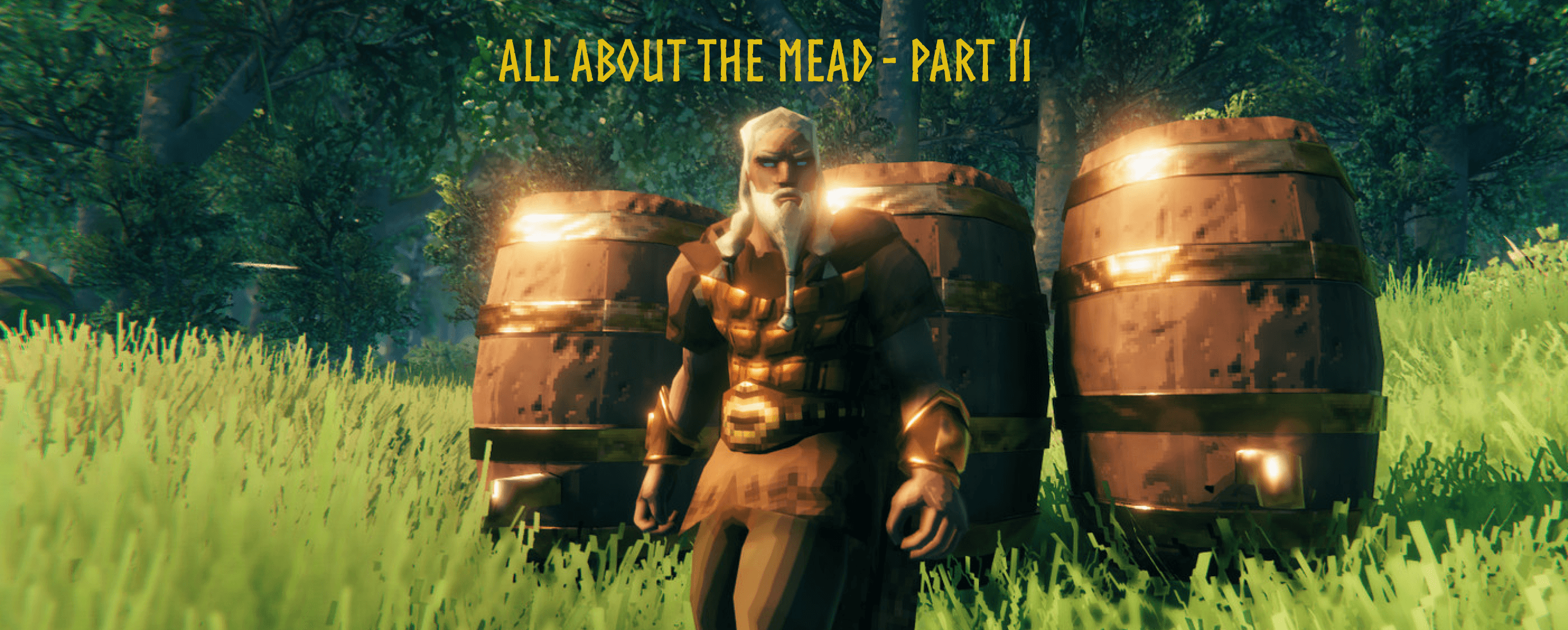
 Christopher R. RiceMay 2, 2023
Christopher R. RiceMay 2, 2023Like our previous post, we’re talking about mead again. That’s right, that delicious beverage made from honey and fruit, which seems to be one of the earliest alcoholic drinks humans ever made. That mead. But we’re talking about it specifically in the context of Valheim. In Valheim, mead is the basis of the game’s potion system. Health potion? Actual mead. Damage resistance potion? Also mead. All is mead. To healy healy you gotta drinky the drinky.
In our last post, we talked about the historical and mythological information about mead. In this post, we’re going to talk about its portrayals in popular culture, how it’s made, how you can make it yourself, and speculation about its purpose and origin within the Valheim universe.
Portrayals in Pop Culture
Mead is kind of all over the place in pop culture – but especially in fantasy, as that’s its natural habitat. Amusingly enough, sometimes the show doesn’t get it right and they are talking more about beer than actual mead.
In the popular TV show, Game of Thrones, mead is frequently consumed (especially by Tyrion Lannister, who always seems to have some kind of drink nearby). The show often features scenes in which the characters share a cup of mead while discussing politics or battle plans. In the book series, A Song of Ice and Fire, by George R.R. Martin (which Game of Thrones is based on), mead is frequently mentioned as a beverage in the fictional world of Westeros. The book also includes a recipe for mead, which is described as "the drink of warriors and kings."
In the video game Skyrim, mead is a common beverage that can be purchased or brewed by the player character. The game also features a quest called "A Night to Remember," in which the player character wakes up with a hangover after a night of heavy mead-drinking.
In the Marvel Cinematic Universe, the character Thor is often depicted drinking mead in his Asgardian home. In the film Thor: Ragnarok, Thor is exiled to the planet Sakaar, where he is forced to participate in a gladiator-style competition and is served a beverage that he describes as "a sugary, fruity drink – not unlike a mead."
J.R.R. Tolkien's epic fantasy series, The Lord of the Rings, frequently mentions mead. The hobbits drink mead in the Prancing Pony Inn in Bree, and the men of Rohan are known for their love of mead.
The historical drama series Vikings (on the History Channel) features several scenes in which mead is consumed, often in large quantities, by the show's characters.
They also unsurprisingly feature the drink in the movie How to Train Your Dragon (2010) and its sequels. Assassin's Creed: Valhalla features mead as a consumable item that restores the player's health and stamina.
Probably my favorite instance of mead in popular culture is this exchange from the movie The 13th Warrior:
Ahmed Ibn Fahdlan: [as Herger offers a mead horn] I can taste neither the fermentation of grape, nor of wheat.
[Herger laughs]
Ahmed Ibn Fahdlan: What? Why do you laugh?
Herger the Joyous: [laughing and handing over the bottle] HONEY! It's made from honey!
Overall, mead has been portrayed in popular culture as a drink with a rich history and cultural significance, often associated with celebrations and communal gatherings.
How Mead Is Made
The process by which mead is made is fairly simple as fermentations go.
First, the container and any equipment used must be sanitized to prevent contamination by unwanted bacteria or fungi. This is a really important step, as harmful microorganisms love the same environments that the good microorganisms do. Afterward, honey and water are mixed (often in a separate container for a thorough mixing, especially in the case of narrow-necked containers). Once mixed, they are added to the fermentation vessel to create what is called "must." Next, yeast is added to the must, and the mixture is stirred to distribute the yeast evenly. This can be done by swirling it, agitating the entire container (if small enough), or by stirring it. Optionally, this process can be skipped if honey, water, and yeast are all combined at the same time.
Once mixed, the yeast begins to consume the sugars in the honey, producing alcohol and carbon dioxide gas as byproducts. The mixture is then left to ferment, usually for several weeks, until the desired alcohol content is reached. Once fermentation is complete, the mead is often clarified: transferred to a clean container to sit till any sediment or cloudiness settle out. Finally, the mead is aged for a period of time, often several months or even years, to allow the flavors to develop and mature.
The specific details of the process can vary depending on the recipe and the desired outcome, but the basic steps outlined above are the key principles involved in making mead.
How You Can Make Mead
Like most alcoholic beverages, mead is a fermentation consisting of water, a sugar, and some kind of bacterial agent. For mead, this is almost always just honey, water, and yeast. Time can be as short as a few weeks, but the longer it's left to ferment, the more profound the flavors will be.
Here is a simple recipe for making mead:
Ingredients:
3 lbs honey
1 gallon water
1 packet of champagne yeast
Equipment:
Instructions:
Sanitize all equipment with a no-rinse sanitizer.
Heat up the water in a pot and mix in the honey until fully dissolved.
Once the honey is fully dissolved, allow the mixture to cool to room temperature.
Transfer the mixture to a sanitized fermenting vessel, using a sanitized funnel.
Add the champagne yeast to the mixture and gently stir it in.
Seal the fermenting vessel with an airlock.
Allow the mixture to ferment at room temperature for 3-4 weeks, or until the bubbling in the airlock has stopped.
After fermentation is complete, siphon the mead into a new, sanitized vessel, leaving behind any sediment or yeast.
Allow the mead to age for at least 3-6 months to improve its flavor and clarity.
After aging, bottle the mead and enjoy!
Mead-making is a craft that can be customized with different honey types, yeasts, and flavors. The recipe above is just one basic recipe, and many brewers experiment with different ingredients and techniques to create unique flavors and styles. For example, fruit is sometimes added for differing flavors and sweetness. Honey might be allowed to crystallize before it’s added to water to rehydrate, and all other manner of minor changes make different-tasting meads. Here, is a decent homebrewing kit.
Valheim Speculation About Mead
So…speculation time. As I’ve said multiple times, Valheim is a world that could be really deep in its lore should the developers decide to go that way. Yes. It’s a survival game. But with some curation, it could be a lot more. So here’s my thought. Why mead? I mean, yes. Viking theme to go with Viking game… but is there a deeper meaning? I think so. What if mead in Valheim is from Heiðrún? This goat produces mystical mead that nourish the Einherjar, who fight eternally during the day in Valhalla and are resurrected at night. Sounds a bit familiar, doesn’t it? What if the reason characters can resurrect in Valheim is because they drank the mead before they came to this place to fight for the Aesir? Makes you think. Mead is very important in the game, as it’s the only way to beat some areas, and buffing potions get more important as the game goes on, with the stamina ones becoming almost needed for some play styles. That’s not even mentioning the magic elixirs and the extra complexity they bring to the table.
Final Thoughts
Here ends the two-part special on mead! I hope you’ve enjoyed it as much as I enjoyed writing it. I think I’m going to order a mead-making kit for myself and see if I can brew some up. I’ve had the homemade stuff before (my girl has made it for me), but that kit is too cheap to pass up and I think it would be neat to be able to say to my friends, “Hey, you want some mead? I brewed it myself.”
Have you ever made mead? When? How? Was it good? Let us know!

Play on Haptic
Try for free


